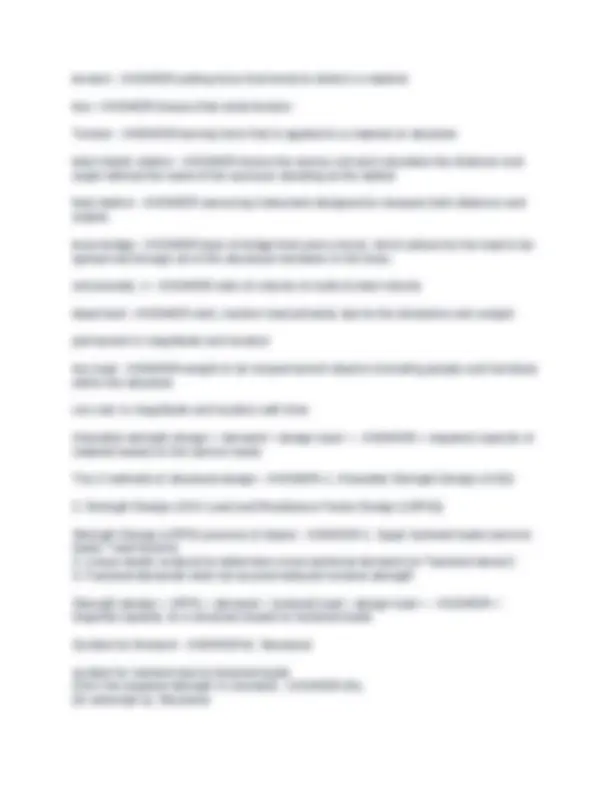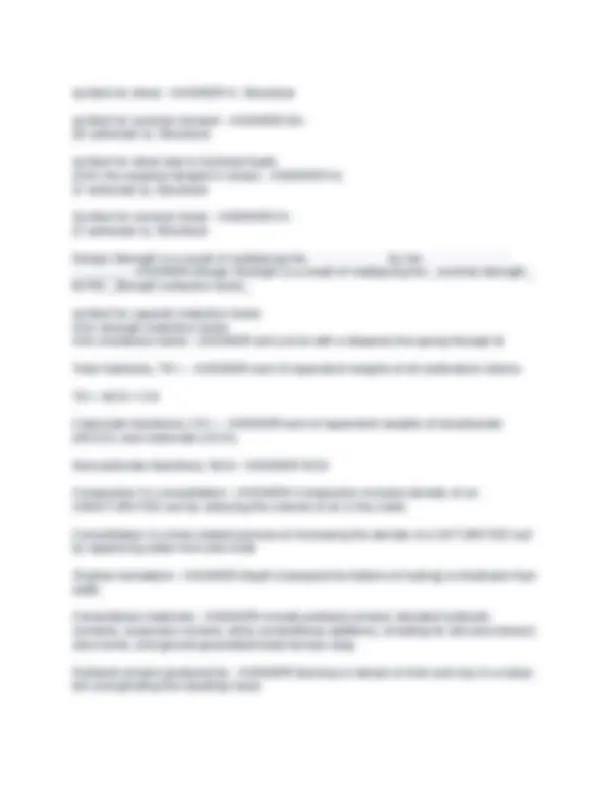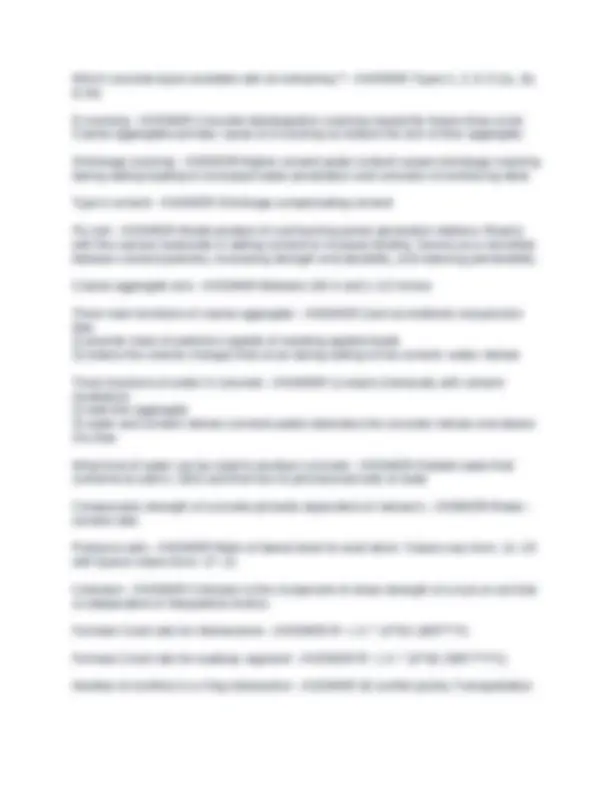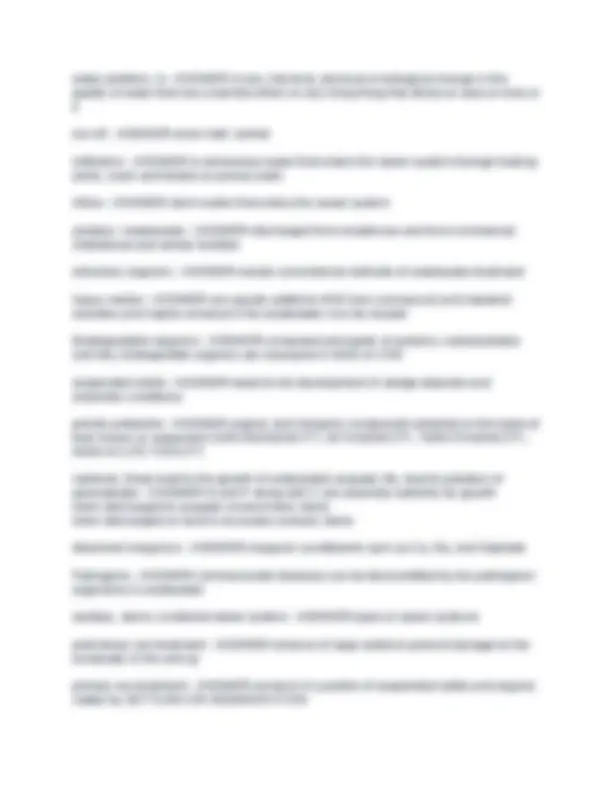








Study with the several resources on Docsity

Earn points by helping other students or get them with a premium plan


Prepare for your exams
Study with the several resources on Docsity

Earn points to download
Earn points by helping other students or get them with a premium plan
Community
Ask the community for help and clear up your study doubts
Discover the best universities in your country according to Docsity users
Free resources
Download our free guides on studying techniques, anxiety management strategies, and thesis advice from Docsity tutors
PE Exam - Civil Breadth with Complete Solutions
Typology: Exams
1 / 12

This page cannot be seen from the preview
Don't miss anything!







Soil void ratio, e - ANSWER-ratio of volume of voids to the volume of solids soil water content, w - ANSWER-ratio of the mass of water to the mass of solids soil density, rho (p) - ANSWER-ratio total mass over total volume allowable stress = - ANSWER-material strength / safety factor allowable strength design method allowable stress - ANSWER-In allowable strength design method, actual calculated stress cannot exceed.... Abutments - ANSWER-structural components that connect the bridge to the ground at the ends of the bridge Arch Bridge - ANSWER-type of bridge that relies on the strength and rigidity of the arch. the strength of an arch is that the structural members are always in compression and that it can distribute the load throughout the arch to the abutments. Beam Bridge - ANSWER-simplest type of bridge used to span the shortest distance Bending - ANSWER-force that causes a structure to sag when placed in the middle of it brace - ANSWER-structural member used to provide structural stability Cantilevered bridge - ANSWER-type of beam bridge that can span greater distances than a simple beam bridge and often includes trusses in the framework central core - ANSWER-reinforced concrete shaft at the center of the building column - ANSWER-vertical structural member that transmits the load from above to other structural elements compression - ANSWER-crushing force down the axis of a material that shortens the material dynamic load - ANSWER-sudden impact on the structure
dynamics - ANSWER-study of forces that cause motion on physical objects electronic distance meter (EDM) - ANSWER-part of the total station, emitting infrared light Equilibrium - ANSWER-state at which structures can oppose external forces and can transfer the load throughout the structure. floor joist - ANSWER-beam that is designed to resist bending as people walk across a floor free body diagram - ANSWER-simple drawing that includes three components: the structural members and joints, the supports, and the loads of forces that are applied Geomatics Engineering - ANSWER-type of engineering usually associated with civil engineering, involves determining the location of objects on the earth joint - ANSWER-Device that connects two or more structural members together Land Surveying - ANSWER-process of taking and using measurements to determine the exact size and shape of a piece of land load - ANSWER-forces the structure must withstand mechanics - ANSWER-study of forces and motion on physical objects Piers; Bridges - ANSWER-main vertical columns that transfer the load of the bridge into the ground shear - ANSWER-force that acts in opposite directions across a material Static Load - ANSWER-weight of the structure itself (known as dead load) and weight added to the structure under normal use (known as live load) Statics - ANSWER-study that deals with the analysis of loads on objects at rest (or in equilibrium) Structural Frame - ANSWER-columns and beams used to build a structure, called a skeleton struts - ANSWER-braces that resist compression suspension bridge - ANSWER-world's longest type of bridges, which utilize tension forces.
symbol for shear - ANSWER-V; Structural symbol for nominal moment - ANSWER-Mn (M subscript n); Structural symbol for shear due to factored loads (AKA the required straight in shear) - ANSWER-Vu (V subscript u); Structural Symbol for nominal shear - ANSWER-Vn (V subscript n); Structural Design Strength is a result of multiplying the ______ _____ by the ______ ______ ________ - ANSWER-Design Strength is a result of multiplying the nominal strength by the strength reduction factor symbol for capacity reduction factor AKA strength reduction factor AKA resistance factor - ANSWER-\phi (circle with a diagonal line going through it) Total hardness, TH = - ANSWER-sum of equivalent weights of all multivalent cations TH = NCH + CH Carbonate Hardness, CH = - ANSWER-sum of equivalent weights of bicarbonate (HCO3-) and carbonate (CO3-) Noncarbonate Hardness, NCH - ANSWER-NCH Compaction Vs consolidation - ANSWER-Compaction increses density of an UNSATURATED soil by reducing the volume of air in the voids Consolidation is a time related process of increasing the density of a SATURATED soil by squeezing water from soil voids Shallow foundation - ANSWER-Depth (measured to bottom of footing) is shallower than width Cementitious materials - ANSWER-Include portland cement, blended hydraulic cements, expansive cement, other cementitious additives, including fly ash pozzolanszl, silica fume, and ground granulated blast furnace slag Portland cement produced by - ANSWER-Burning a mixture of lime and clay in a rotary kiln and grinding the resulting mass
Which concrete types available with air entraining? - ANSWER-Types 1, 2, & 3 (1a, 2a, & 3a) D cracking - ANSWER-Concrete disintegration cracking caused by freeze-thaw cycle. Coarse aggregates primary cause of d cracking so reduce the size of Max aggregate. Shrinkage cracking - ANSWER-Higher cement paste content causes shrinkage cracking during setting leading to increased water penetration and corrosion of reinforcing steel. Type k cement - ANSWER-Shrinkage compensating cement Fly ash - ANSWER-Waste product of coal burning power generation stations. Reacts with the calcium hydroxide in setting cement to increase binding. Serves as a microfiller between cement particles, increasing strength and durability, and reducing permeability. Coarse aggregate size - ANSWER-Between 3/8 in and 1 1/2 inches Three main functions of coarse aggregate - ANSWER-1)act as relatively inexpensive filler
physiochemical processing of wastewater to reduce levels of inorganic nutrients chemical precipitation - ANSWER-is accomplished by producing a precipitate that will settle adsorption - ANSWER-involves removal of specific compounds from wastewater on solid surfaces using the forces of attraction between bodies screening, environmental - ANSWER-first operation performed on incoming wastewater for the purpose of removing material coarse screens - ANSWER-vertical bars spaced 1 cm or more that are inclinded fine screens - ANSWER-consists of woven wire or clothes or perforated plates mounted. they are mechnically cleaned in a continous basis bar racks - ANSWER-3-4 in apart, filter out larger debris bar screens - ANSWER-in water reclamation, these remove large objects from the water; 0.5 to 1.5 cm apart to filter out smaller debris capture rate - ANSWER-6 ft3/million gal screenings - ANSWER-are coated with organic material of very objectionable nature and should be promptly disposed to prevent health hazard Backflow, wastewater - ANSWER-reverse flow of contaminants through a cross- connection into the potable water supply; this causes the inffectiveness of screening, as a result H2s will be formed in the septic tank band screen - ANSWER-perforated belt passes oven an upper and lower roller perforated plate screen - ANSWER-consists of a fixee band of perforated screens wing screens - ANSWER-has radial vanes which rotates ..... disk screen - ANSWER-circular perforated disk with or without supporting bars grating screen - ANSWER-2 parallel sets of screen mesh screen - ANSWER-ckmposee of fabric with size that depends on the floting and suspended matter communitor - ANSWER-screeninga are sometimes shredded and returned to the wastewater and will undergo under this eqpmt
Hammermil device - ANSWER-8 mm in size, solid remain water often used for this purpose This ___ mean speed is always greater than or equal to this ___ mean speed. - ANSWER-What are time-mean speed and space-mean speed, respectively? mode or modal speed - ANSWER-___ = the most frequently occurring value in the distribution is free-flow speed - ANSWER-___ = a standard linear flow-speed model, the speed at max flow is exactly 1/2 of this. Spacing - ANSWER-___ = the distance between successive vehicles as they pass a given point [often measured from the front bumper of the vehicle]. Calc. spacing (S) in ft - ANSWER-___ = 5280/density (Transportation) Calc time between successive veh (sec/veh) - ANSWER-___ = 3600/V (Transportation) Formula for Headway - ANSWER-___ = Spacing / S where S is the space mean speed mph Headway - ANSWER-___ = the time difference between successive vehicles as they pass a given point [often measured from the front bumper of the vehicle]. Flow Rate, Transportation Definition - ANSWER-___ = the number of vehicles that pass a point on a roadway during a specified time interval (hour, day, annual). Density, Transportation Definition - ANSWER-___ = the number of vehicles occupying a specified length of roadway which is often given as vehicles per mile. Density, Transportation formula - ANSWER-=v/S [Flow volume divided by space mean speed] Calculates number of vehicles per hour per lane (vphpl) - ANSWER-v=S*D [Space mean speed time Density] Calculates number of vehicles per mile per lane - ANSWER-D=v/S (Transportation) Formula for peak hour factor - ANSWER-=total volume/4xV Perception Reaction - ANSWER-___ = the Human factor often cited by engineers concerned with safety. P R T see something on the road and react to it. Does not include full stopping time.
water pollution, is - ANSWER-is any chemical, physical or biological change in the quality of water that has a barmful effect on any living thing that drinks or uses or lives in it run off - ANSWER-snow melt. rainfall infiltration - ANSWER-is extraneous water that enters the sewer system through leaking joints, crack and breaks or porous walls inflow - ANSWER-storm water that enters the sewer system sanitary / wastewater - ANSWER-discharged from residences and from commercial institutional and similar facilities refractory organics - ANSWER-resists conventional methods of wastewater treatment heavy metals - ANSWER-are usually added to WW from commercial and industrial activities and maybe removed if the wastewater is to be reused. Biodegradable organics - ANSWER-composed principally of proteins, carbohydrates and fats, biodegradble organics are measured in BOD or COD suspended solids - ANSWER-leads to the development of slhdge deposits and anaerobic conditions priority pollutants - ANSWER-organic and inorganic compounds selected on the basis of their known or suspected CARCINOGENICITY, MITAGENICITY, TERATOGENICITY, HIGH ACUTE TOXICITY nutrients, these lead to the growth of undesirable acquatic life, lead to pollution of groundwater - ANSWER-N and P along with C are essential nutrients for growth when discharged to acquatic environment, blank when discharged on land in excessive amount, blank dissolved inorganics - ANSWER-inorganic constituents such as Ca, Na, and Sulphate Pathogens - ANSWER-communicable diseases can be btransmktted by the pathogenic organisms in wastewater sanitary, storm, combined sewer system - ANSWER-types of sewer systems preliminary ww treatment - ANSWER-removal of large solids to prevent damage to the remainder of the unit op primary ww treatment - ANSWER-removal of a portion of suspended solids and organic matter by SETTLING OR SEDIMENTATION
60% solids - ANSWER-Primary ww treatment removes how much of solids 30% BOD - ANSWER-Primary ww treatment removes how much of BOD barminutor - ANSWER-vertical bar screen with a cutting head that travels up and down the rack bars, shredding the interrupted material channel design - ANSWER-the length and width of a (the distribution) channel grit - ANSWER--not biodegradable and occupies valuable space in digesters -abrasive in nature and will cause accelerated wear on pumls and sludge handling eqpmt -it is desirable to separate them from the organic suspended solids grit removal facilities - ANSWER-basically consist of an enlarged channel area whee reduced flow velocities allow grit to settle out vortex type grit chamber - ANSWER-vortex flow aerated grit chamber - ANSWER-a type pf chamber where in compressed air is injected to keep lighter organic material in suspension while the heavier grit falls to the bottom channel type, horizontal flow grit chamber - ANSWER-oldest type of grit chamber parshall flumes - ANSWER-(most common) flow measurement devices palmer bowlus flumes - ANSWER-most common flow measurement devices 0.6 m/s, wastewater treatment - ANSWER-fluid velocity in the sewer 0.3 m/s, wastewater treatment - ANSWER-fluid velocity in the grit removal fraction of 0.3 m/s, wastewater treatment - ANSWER-fluid velocity in the primary treatment sedimentation - ANSWER-the separation from water, by gravitational settling of suspended particles that are heavier than water inlet structure - ANSWER--allows water to enter storm sewer -slows down the flow and distributes it evenly short circuiting, wastewater - ANSWER-major problem in the design of sedimentation tanks, water has preferred route (tends to follow shorter route)